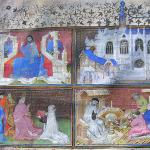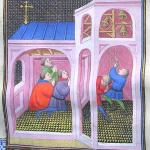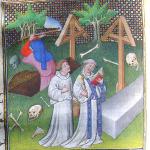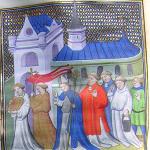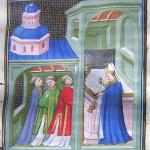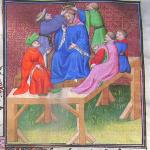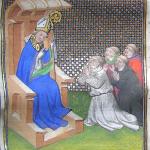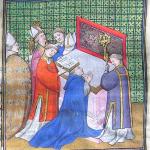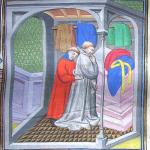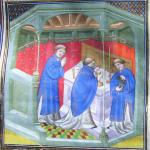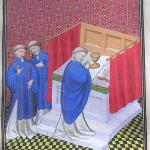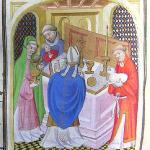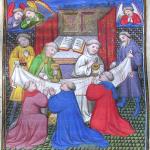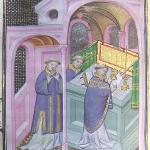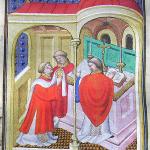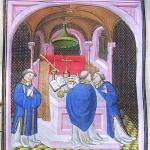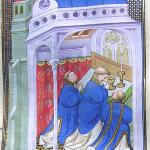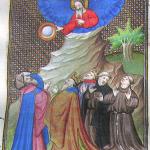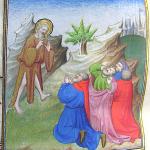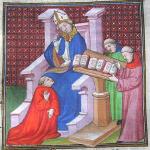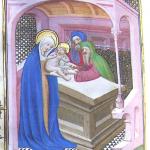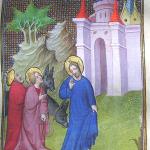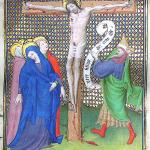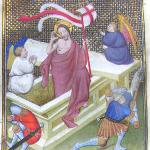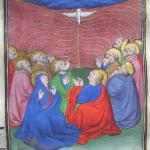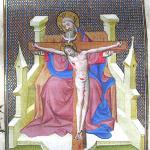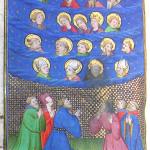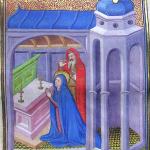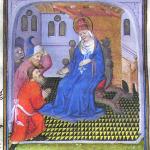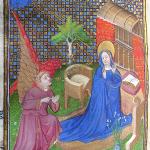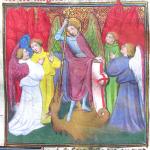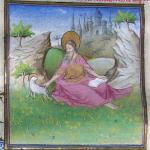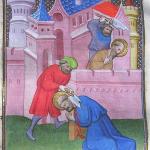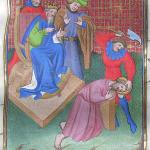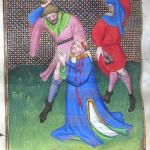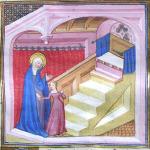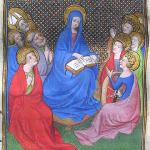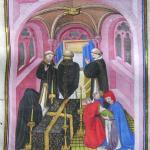DURANDI RATIONALE GALLICE
Vellum, 14.25 x 10.25, ff. 359 + 2, double columns of 40 lines. Early 15th cent., very fine writing and illumination.
Donor, William Grove, B. D., Fellow, 1762. 2 fo. ne sont cy.
At foot of f. 1:
Ex libris Biblio. D. D. Caroli de Pradel episcopi Montep(essulanensis).
The history of this book before its presentation to the College is fully set forth in the paragraphs quoted in the Introduction from M. Meyer’s pamphlet.
In the sale catalogue of the de Pradel-Colbert de Croissi library 1740, it is described as “relié en bois couvert de velours cramoisi.” This is no longer the case: the binding is brown leather of 18th cent.1
Collation : 2 flyleaves, 18 – 148 (8 ? canc.) 158 168 (wants 3) 178 – 228 2310 248 (wants 1) 258 268 (wants 4, 5) 278 (wants 3) 288 – 398 (wants 6) 408 – 448 (wants 4) 458 (4 canc.) 468 (7, 8 canc.).
Contents:
The rationale of Durandus of Mende, in French.
Cy commence racional du diuin office translate de latin en francois
par maistre Jehan Golein de lordre de nostre dame de carme
docteur en theologie par le commendement du roy charles le
quint qui regnoit lan m. trois cens. lxxix . . . f. 1
Prol. Toutes les choses qui sont appartenantes au deuin office
-et de celle de mors.
Cy commence le premier liure qui est de leglise des lieus sacres
des aournemens et consecracions. le premier chapitre 3
En ceste primiere partie sera traitie et dit.
Lib. II, f. 48; III, 61; IV, 77b; V, 154; VI (first leaf gone), 185;
VII, 331b.
Ends 352b: la table de ceste liure se declaire par le commence-
ment de chascun des liures.
f. 353 blank.
Table of chapters . . . . . . 354
Ends f. 358a:
Le viiie liure est laisses aus astronomiens.
358b, 359 blank.
The two flyleaves at the beginning have been formerly bound in the reverse order. On the 1st is a set-off of the painting on f. 1 of text.
The miniatures are productions of the fine school of artists who illuminated so many of the translations done for Charles V. Another good example of their work may be seen in Cambridge in Fitzwilliam MS. 251 (Bartholomaeus Anglicus). The borders are of fine ivy leaf.
1. Painting in four compartments occupying rather less than half the page. It has unhappily suffered somewhat from damp.
a. Red ground, divided by gold lines into lozenges. Christ, in blue, on a large stone throne, blessing, with orb. On either arm of the throne is an arch: through each looks a blue angel holding (L.) a chalice, (R.) tables of law.
b. Chequer. A stone church (seen from south) with blue roof and central fleche. Large traceried windows. A stairway with roof supported by wooden posts leads up to the west door: a southern transeptal chapel, with circular window, on a lower level. A stone-walled yard.
c. Chequer. Charles V in a chair (3 men behind it) receives the book bound in red from the kneeling translator in Carmelite habit (white over black).
d. Red, with gold flourishing. The translator in his habit sits on L. in canopied wooden seat, at hexagonal desk with screw-post. Three students sit reading and listening on wooden seats on R.
Full border.
2. f. 17b. Des cloches et de leur son. Chequer. Church with pink walls and blue roof. The side is taken away, so as to show three worshippers in the body of the church, and two men ringing two (of three) bells in the tower.
3. f.19b. Des cymetiers, etc. Chequer. Priest with book and asperge, deacon with holy water, in churchyard: a stone tomb, two wooden crosses, a man digging a grave, bones lying about. Trees behind.
4. f. 22b. De la dedicacion de leglise. Chequer. Church seen from south, plain round-headed windows, central octagonal tower and spire, and large high western porch. In front a procession walking westward: clerk in alb, with textus, friar with bannered cross, Bishop in blue cope, deacon in red dalmatic, clerk with bucket and asperge, another, and a layman.
5. f. 29. Dedication of altar. Chequer. Church with central octagon seen in section; chancel on R. represented as higher. Coped Bishop with censer and book at south end of altar, two deacons, one with crosier, and clerk in cope.
6. f. 37. Coronation of king. Red ground with gold pattern in squares. The king in blue mantle sits on a wooden platform supported by 4 posts: grass below. Two laymen place the crown on his head. Three robed courtiers sit on the platform. No other figures.
7. f. 48. Lib. II. Chequer. Bishop in blue cope sits blessing, on canopied wooden seat. On R. kneel a white monk, a black monk, and two laymen. Full border.
8. f. 59. De leuesque. Green ground with gold pattern in squares. Altar with retable of flourished work: at south end a deacon with crosier. A Bishop in blue cope kneels at the altar and a deacon in red dalmatic opens a book of the Gospels over his head. At the north end two Bishops, a deacon holding mitre.
9. f. 61. Lib. III. In a paved room: a priest in alb facing R., a server in red gown girds him with girdle: a stole and blue and red vestments lie on an altar on R. Full border.
10. f. 77b. Lib. IV. In an octagonal stone building priest in blue chasuble at altar breaks the Host over the chalice. Deacon in blue on R. with cruet, one on L. with joined hands. Full border.
11. f. 116. Du canon qui est dist en secret. Red ground, gold pattern in squares. Altar with plain panelled retable, and red riddles. Priest in blue chasuble, etc., before it. On it chalice, paten, Host (on the altar) and book. Two deacons in blue on L.
12. f. 116b. De lexposicion du canon. Chequer. Mitred prelate at altar reading from book (back turned). At S. end clerk (Abel) in red robe carrying a lamb: at N. Melchizedek (clerk in green, red and white) carrying flagon and cake. Beyond him a man carrying a child (Abraham?).
13. f. 119. Altar in background with red riddles. In front two men hold a houselling cloth. Behind this a priest in green cope with Host and chalice and a cleric in alb with chalice administers to three kneeling men. In air three demi-angels adore.
14. f. 121b. La quinte part de la messe. Priest in purplish chasuble, at altar, holds the Host. Two deacons on L.
15. f. 144. De prendre la platenne. Altar with green retable, gold cross, and candles. Priest in scarlet chasuble. Deacon in scarlet dalmatic takes the paten and folds it in or unwraps it from linen. Another beyond.
16. f. 147. De la paix. Priest in blue chasuble at altar kisses deacon on R. One on L. with joined hands.
17. f. 148b. Communion of the Priest. He receives the Host. The two deacons on either side of him genuflect. Blue vestments. Tower of church seen beyond.
18. Lib. V. f. 154. Of the daily and nightly offices. Chequer. In C. a rocky mount. At top of it, in a blue starred cloud, God, in red robe, half-length, holds out a white convex mirror2 in a round frame. Below a prophet, two kings, a monk in black over brown, and a Franciscan friar look up. Trees on R. with the foliage tapering into some six points.
[Lib. VI (first leaf gone) treats of the Proper of Time.]
19. f. 189b. 1st Sun. in Advent. In a landscape with rocks and a “seven-pointed” tree, John Baptist on L. in a beast’s skin addresses a group of four men who kneel on R.
20. f. 199. Ember days. Red ground, patterned. Bishop in blue cope enthroned: before him kneels a clerk in scarlet robe. On a desk on R. are three open books and two clerks in green and pink stand on R.
21. f. 206b. Candlemas. The Virgin holds the nude Child. Symeon and another man behind the altar. The former bends forward to receive the Child.
22. f. 244. Palm Sunday. Chequer. On L. two apostles each leading an ass. In C. Christ in blue speaks to them. In background on L. rocks and characteristic trees: on R. towered city with gate.
23. f. 263. Good Friday. Chequer. Christ on the cross (T-shaped). On L. the Virgin swooning, John, and three women (?). On R. the centurion (in robes, chiefly green) with scroll: Vere filius dei erat iste.
24. f. 285b. Easter. Chequer. Christ in red mantle steps out of the tomb to R. His resurrection cross has white banner with red cross. The lid of the tomb is cross-wise and an angel kneels on it; another is on the edge of the tomb on L. Two soldiers: one sleeps, one is terrified.
25. f. 308b. Pentecost. Pink ground, blue cloud at top. The Apostles and Virgin kneel. The Dove descends vertically, and from it proceed a vertical ray and curved rays branching out of that.
26. f. 314. Trinity. Chequer. The Father throned supports before Him the crucified Son, over whom is the Dove. The robe of the Father is red lined with dark blue.
27. f. 331b. Lib. VII. Of Saints’ days. Blue starred sky above, chequer below. At top four zones: in each a row of heads (1) 4 Apostles, (2) 5 Virgins, one crowned, (3) Stephen and 4 other matyrs, (4) 3 Bishops and a monk. On the ground below kneel two groups, each of three, men and women.
28. f. 337b. Purification. In a chapel with a pretty hexagonal domed turret at the corner the Virgin kneels (face L.) and Joseph in red stands before an altar with green retable and candlesticks.
29. f. 338. Chair of Peter. In a paved room with silvered windows Peter, beardless, in blue robe and red tiara, with keys, sits in canopied seat. Three suppliants on L. approach, one in fine scarlet and gold dress.
30. f. 338b. Annunciation. Chequer. The Virgin kneels on R. on a gold carpet before a wooden canopied desk with red curtains. A chair, grass and trees. The angel kneels on L. The words ave gracia plena are written in yellow proceeding from his mouth. In upper L. corner, bust of the Father breathing forth rays.
31. f. 339b. The Angels. Michael in C. standing on the dragon, with spear and red-cross shield. Two angels on R., two on L. Red seraphs on R. and L. behind.
32. f. 340. John Baptist. He sits on the grass in a landscape, pats a lamb on L., and has book on his knee. Rocks, trees and city behind.
33. f. 341. Peter and Paul. Both are being beheaded by executioners with axes, one outside a city wall, the other within. Chequered ground.
34. f. 342. James the Great. A king throned on L., a chair on square platform. Two courtiers by him. James in front is beheaded on a block with an axe. Red ground with gold pattern in squares.
35. f. 342b. Stephen kneeling, in blue dalmatic, is stoned by two men. Chequered ground.
36. f. 343b. Nativity of the Virgin. She stands, a child in pink dress, by St Anne, in blue, who holds her hand, at the foot of a flight of five stone steps with an altar at top, in a stone building. This represents the Presentation, not the Nativity.
37. f. 344. All Saints. Chequer. The Virgin seated in C. with open book. On R. sit Katherine, two other crowned Virgins, and others not crowned: on L. John, Peter, another apostle, a Bishop; other nimbi seen behind.
38. f. 344b. The Dead. In a church looking East. In front a coffin with black and gold pall, and candles about it. On R. kneel a man and a woman with book, on L. a mourner. At the altar a priest, deacon and subdeacon in black and gold vestments.
Each chapter has a small good initial with sprigs of ivy leaf springing from it. The whole book is a very fine example of its class.
Claudia Rabel, 'L'illustration des Rational des divins offices de Guillaime Durand', Guillaume Durand Eveque de mende: Actes de la Table Ronde du CNRS 1990 (Paris, 1992), pp. 171-80.
Pamela Nourrigeon, De la translatio à la création : les images dans les manuscrits du Rational des divins offices (Paris : Les Éditions du Cerf, 2018)
Exhibited (f.77v) at the Fitzwilliam Museum, Cambridge, from 26 July to 11 December 2005. See the exhibition catalogue: P. Binski and S. Panayotova (eds.), The Cambridge Illuminations: Ten Centuries of Book Production in the Medieval West (London: Harvey Miller, 2005) no. 53, fig. 20.
1. A shield, indecipherable to me, is painted on the fore-edge.
2. "Fac secundum exemplum quod tibi monstratum est in monte, Exod. xxv."
